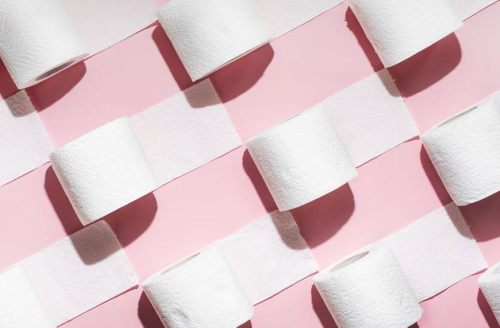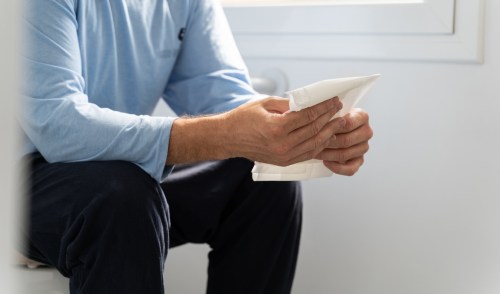5 Telltale Signs You Have Healthy Poop (Including Clean Toilet Paper Post-Wipe)
Discover the signs of healthy poop, like color, consistency, and frequency, to learn more about the status of your own digestive health.

Going number two. You have the routine down to a science by now, right? You go, you wipe, and then you flush. Simple enough. But what if recently the “go” part leaves you in a full-body sweat from straining, or the “wipe” part has you burning through more rolls of TP than you ever thought possible? These may be signs of unhealthy poop, and that you’ve got some underlying gut health issues going on.
A healthy poop will often have a certain color, shape, and consistency—which is easy to wipe clean just a few squares of toilet paper, BTW. In fact, your TP should (more often than not) come up clean after wiping. If it’s a messy situation, or you need to use wads of crumpled paper, this may mean your poop is too soft. This could be a product of your diet, a food intolerance, stress, or an imbalanced microbiome (i.e., the good and bad bacteria in your gut).
Here, learn about the characteristics of a healthy poop or “normal” bowel movements, and how much toilet paper you should actually be using when wiping (not just to save money or the environment, but for the sake of your bum, too), according to a gastroenterologist.
1. It’s brown
“The first [thing] is color,” says Niket Sonpal, MD, a gastroenterologist at Baylor Scott & White Health in Texas. “Stool should be consistent in color.” More specifically, a healthy poop color is like dirt—aka, a lighter brown to a darker brown.
Anything that looks green, light-colored white, yellow, black, or red warrant a call to your doctor, per the Mayo Clinic. But if a peek into the bowl reveals a Pantone-style match for the classic poop emoji, you’re one step closer to a healthy poop. If you’re still unsure, you can refer to a stool color chart online to get a better idea.
TIP
The Bristol stool chart is a helpful tool doctors may use to categorize fecal color and shape. You can find versions of the chart online.
2. It’s not too hard or soft
The next-poo criteria has to do with consistency, according to Dr. Sonpal. “The quality should be not too hard and not too soft—it’s a Goldilocks phenomenon,” he adds. “You also shouldn’t see any undigested food chronically. It’s fine to see some corn on the way out, but if it’s happening chronically, then that may be a sign that your body’s not getting enough nutrients or a sign of malabsorption.”
Keep in mind: Stool consistency can sometimes be regulated through fiber intake. Eating enough fiber every day (about 25-30 grams, per UCSF Health) can help firm up your stool texture and get it moving through your digestive tract.
3. It sinks (not stinks)
Next up? Check the toilet for any floating poop or fluffy poop. “When your stool floats, that means there’s a lot of fat in it and your intestines are potentially damaged,” says Dr. Sonpal. This can be caused by the following, per Penn Medicine:
- Malabsorption, or poor absorption of nutrients
- Too much gas in your gut, which can happen with a change in your diet
- A GI infection
- Pancreatitis
Anything that looks particularly fatty or fluffy, especially on a consistent basis, could mean an underlying condition. And while poop is (naturally) going to smell unpleasant, if it starts smelling different or particularly foul, that could also be a red flag for things like inflammatory bowel disease (IBD) or an intestinal infection, per Penn Medicine. If this sounds familiar, it’s time to make an appointment with your doc.
4. It’s not too long or skinny
Are really long poops healthy? For some people, yes. But poop that’s both long and particularly narrow (aka, skinny poop) could be a sign that something’s off. Very thin stool could be a product of irritable bowel syndrome (IBS), or it could be a sign that your colon is narrowing or has a blockage, per the Mayo Clinic.
While thin poop every now and then is not likely cause for concern, chronically thin poop should be checked out by your doctor. They may suggest getting a colonoscopy—an exam that uses a tube with a camera on the end to check the inside of your intestines for any abnormalities.
5. It’s fairly easy to pass and wipe
Last, but certainly not least, a healthy bowel movement should not require excess effort to eliminate. This means, it shouldn’t always feel painful or difficult to poop.
“There should be no strain while passing,” Dr. Sonpal explains. “When people sit, they should have one to two major pushes where everything comes out in a vacuum.” If you see small, pellet-like stools in the toilet bowl—which Dr. Sonpal calls “rabbit poops”—then you’re likely constipated and could benefit from some fiber or more water (hydration and digestion go hand in hand, after all).
It also shouldn’t take you too long to poop, either. While everyone is different, the average is about 10 seconds to one minute. According to the Cleveland Clinic, five minutes should be about the maximum time you spend in the bathroom. (And yes, it’s normal to poop three times a day or more, as long as it’s not painful or too watery!)
Lastly, wiping should be a breeze. If you’re always left with lots of stool on your TP, or have to wipe several times to get fully clean, you may have an underlying condition making your stool soft—like IBS, a food intolerance, or an IBD. Wiping too much can lead to irritation of the skin on your anus and rectum.
Tips for achieving healthy poop
Other than monitoring the state of your stool, there are other things you can try to achieve healthy poops. This can include:
- Eating enough fiber: As mentioned, aim for about 25 to 30 grams per day. Try things like oatmeal, bran, apples, or broccoli, per the Mayo Clinic. Or you can take fiber supplements.
- Drinking enough water: The National Academies of Sciences, Engineering, and Medicine recommend getting 11.5 to 15.5 cups of water per day, through drinking and eating water-rich foods (i.e., watermelon, cucumbers, etc.)
- Getting daily exercise: Moving for just 30 minutes per day (think: going for a walk, biking, etc.) can help move your bowels, per the Cleveland Clinic.
- Taking a probiotic: Probiotics can introduce more good bacteria to the gut, which may help ease constipation, per Harvard Health Publishing.
- Reducing stress: Managing the effects of stress through relaxing activities, like meditation, journaling, yoga, or breathing exercises, could help reduce IBS symptoms, per NYU Langone Health.
- Checking in with your doctor: If you’ve done all of the above, and continue to have abnormal stool with other symptoms like pain, then you might have a GI condition. Your doctor can help you figure this out.
When to see a doctor
Your poop’s color, shape, and consistency can tell you a lot about your bowel health. An ideal BM should be a shade of brown, firm, dense enough to sink to the bottom of the bowl, and easy to pass and wipe.
If you’re having pain when passing stool, chronic diarrhea or constipation, blood in your stool, or changes to your poop’s smell or shape, reach out to your doctor. They can run stool sample tests and other exams to rule out any underlying issues.
Treatment for GI conditions vary, but could include lifestyle changes like eating more fiber, limiting greasy, fatty, or ultra-processed foods, and getting daily exercise. It could also include medications like antibiotics (if an infection is present), IBS medications, anti-inflammatories, and more.
—reviewed by Jennifer Gilbert, MD, MPH
Sign Up for Our Daily Newsletter
Get all the latest in wellness, trends, food, fitness, beauty, and more delivered right to your inbox.
Got it, you've been added to our email list.










